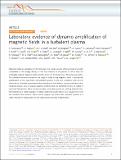Laboratory evidence of dynamo amplification of magnetic fields in a turbulent plasma
Author(s)
Tzeferacos, P.; Rigby, A.; Bott, A. F. A.; Bell, A. R.; Bingham, R.; Casner, A.; Cattaneo, F.; Churazov, E. M.; Emig, J.; Fiuza, F.; Forest, C. B.; Foster, J.; Graziani, C.; Katz, J.; Koenig, M.; Meinecke, J.; Petrasso, R.; Park, H.-S.; Remington, B. A.; Ross, J. S.; Ryu, D.; Ryutov, D.; White, T. G.; Reville, B.; Miniati, F.; Schekochihin, A. A.; Lamb, D. Q.; Froula, D. H.; Gregori, G.; Li, Chikang; ... Show more Show less
Downloads41467-018-02953-2.pdf (1.794Mb)
PUBLISHER_CC
Publisher with Creative Commons License
Creative Commons Attribution
Terms of use
Metadata
Show full item recordAbstract
Magnetic fields are ubiquitous in the Universe. The energy density of these fields is typically comparable to the energy density of the fluid motions of the plasma in which they are embedded, making magnetic fields essential players in the dynamics of the luminous matter. The standard theoretical model for the origin of these strong magnetic fields is through the amplification of tiny seed fields via turbulent dynamo to the level consistent with current observations. However, experimental demonstration of the turbulent dynamo mechanism has remained elusive, since it requires plasma conditions that are extremely hard to re-create in terrestrial laboratories. Here we demonstrate, using laser-produced colliding plasma flows, that turbulence is indeed capable of rapidly amplifying seed fields to near equipartition with the turbulent fluid motions. These results support the notion that turbulent dynamo is a viable mechanism responsible for the observed present-day magnetization.
Date issued
2018-02Department
Massachusetts Institute of Technology. Plasma Science and Fusion CenterJournal
Nature Communications
Publisher
Nature Publishing Group
Citation
Tzeferacos, P., et al. “Laboratory Evidence of Dynamo Amplification of Magnetic Fields in a Turbulent Plasma.” Nature Communications, vol. 9, no. 1, Dec. 2018.
Version: Final published version
ISSN
2041-1723